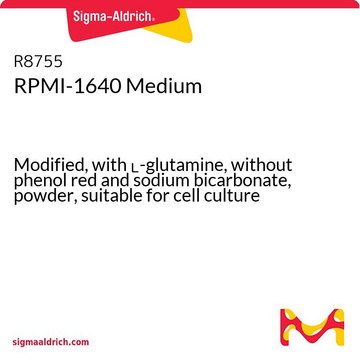R1383
Meio RPMI-1640
With ʟ-glutamine, without glucose and sodium bicarbonate, powder, suitable for cell culture
Sinônimo(s):
Roswell Park Memorial Institute 1640 medium
Faça loginpara ver os preços organizacionais e de contrato
About This Item
Produtos recomendados
Nome do produto
Meio RPMI-1640, With L-glutamine, without glucose and sodium bicarbonate, powder, suitable for cell culture
Formulário
powder
técnica(s)
cell culture | mammalian: suitable
componentes
L-glutamine: yes
phenol red: yes
sodium pyruvate: no
HEPES: no
NaHCO3: no
Condições de expedição
ambient
temperatura de armazenamento
2-8°C
Procurando produtos similares? Visita Guia de comparação de produtos
Descrição geral
O meio RPMI 1640 foi desenvolvido no Instituto Roswell Park Memorial, em 1966, por Moore e seus colaboradores. Uma modificação do meio 5A de McCoy. Ele foi formulado para dar suporte a células linfoblastoides em cultura de suspensão, mas desde então demonstrou ser capaz de fornecer suporte a uma ampla gama de células dependentes de ancoragem. Destinado originalmente para ser usado com um suplemento de soro, demonstrou-se que o RPMI 1640 dá suporte a diversas linhagens celulares na ausência de soro. Ele também foi usado amplamente nos protocolos de fusão e no crescimento de células híbridas. Esse meio é adequado para a cultura de leucócitos humanos normais e neoplásicos.
Aplicação
RPMI-1640 Medium has been used as a cell culture medium to culture human MCF-7 breast cancer cells and human castrate-resistant prostate cancer (CRPC) cell lines for various cell culture experiments. It has also been used to culture human islets to assess the oxidative stress response in primary human islets.
Quantidade
Formulated to contain 8.4 grams of powder per liter of medium.
Reconstituição
Supplement with 2.0 g/L sodium bicarbonate.
geralmente comprado junto com este produto
Nº do produto
Descrição
Preços
suplemento
Nº do produto
Descrição
Preços
Código de classe de armazenamento
13 - Non Combustible Solids
Classe de risco de água (WGK)
WGK 1
Ponto de fulgor (°F)
Not applicable
Ponto de fulgor (°C)
Not applicable
Escolha uma das versões mais recentes:
Já possui este produto?
Encontre a documentação dos produtos que você adquiriu recentemente na biblioteca de documentos.
Os clientes também visualizaram
Jiayi Yao et al.
Cancers, 12(8) (2020-08-09)
The acidic pH of the tumor microenvironment plays a critical role in driving cancer development toward a more aggressive phenotype, but the underlying mechanisms are unclear. To this end, phenotypic and genotypic changes induced by adaptation of cancer cells to
Qinxi Ma et al.
mSphere, 4(3) (2019-06-28)
Fatty acids have known antifungal effects and are used in over-the-counter topical treatments. Screening of a collection of gene knockouts in Candida albicans revealed that one strain, carrying a deletion of the transcription factor DAL81, is very susceptible to the
Mette Flinck et al.
Cell cycle (Georgetown, Tex.), 17(9), 1056-1067 (2018-06-14)
Precise acid-base homeostasis is essential for maintaining normal cell proliferation and growth. Conversely, dysregulated acid-base homeostasis, with increased acid extrusion and marked extracellular acidification, is an enabling feature of solid tumors, yet the mechanisms through which intra- and extracellular pH
Michael D Lewis et al.
The American journal of tropical medicine and hygiene, 81(6), 1041-1049 (2009-12-10)
Trypanosoma cruzi, the agent of Chagas disease, can be subdivided into six discrete typing units (DTUs), TcI, TcIIa, TcIIb, TcIIc, TcIId or TcIIe, each having distinct epidemiologically important features. Dozens of genetic markers are available to determine the DTU to
Sven D Willger et al.
PLoS pathogens, 4(11), e1000200-e1000200 (2008-11-08)
At the site of microbial infections, the significant influx of immune effector cells and the necrosis of tissue by the invading pathogen generate hypoxic microenvironments in which both the pathogen and host cells must survive. Currently, whether hypoxia adaptation is
Nossa equipe de cientistas tem experiência em todas as áreas de pesquisa, incluindo Life Sciences, ciência de materiais, síntese química, cromatografia, química analítica e muitas outras.
Entre em contato com a assistência técnica





